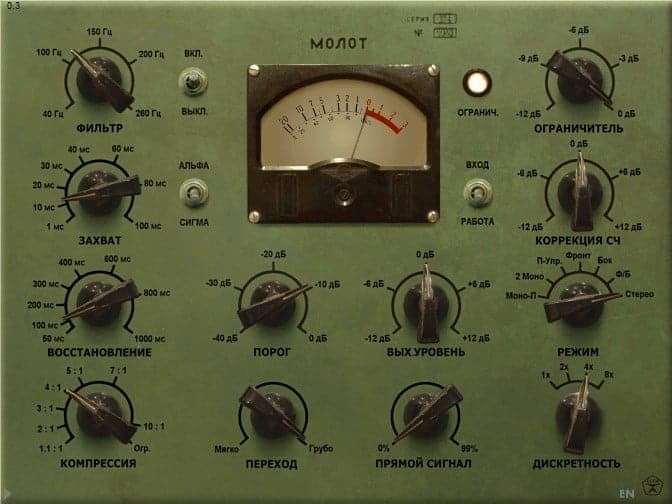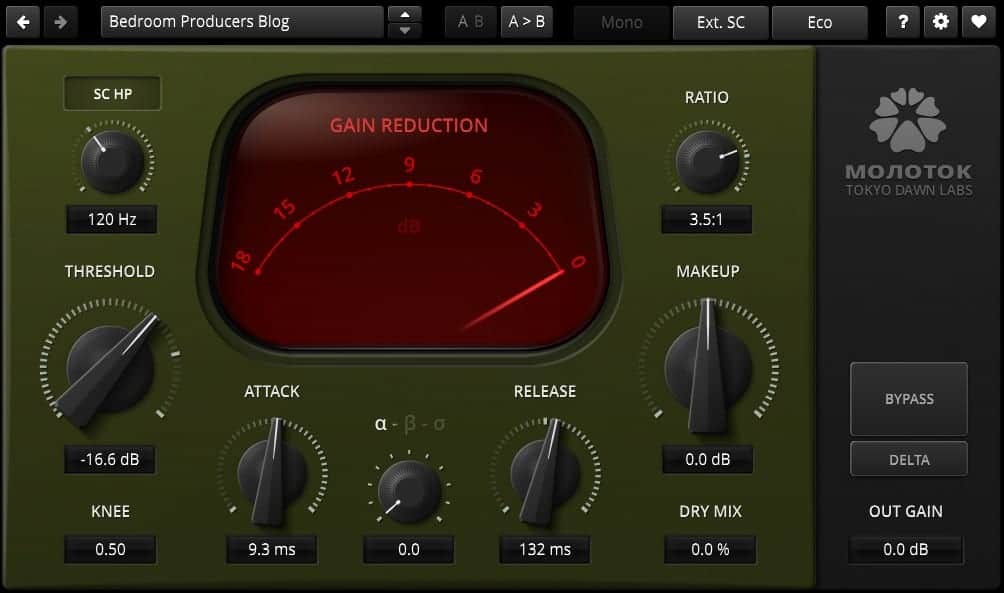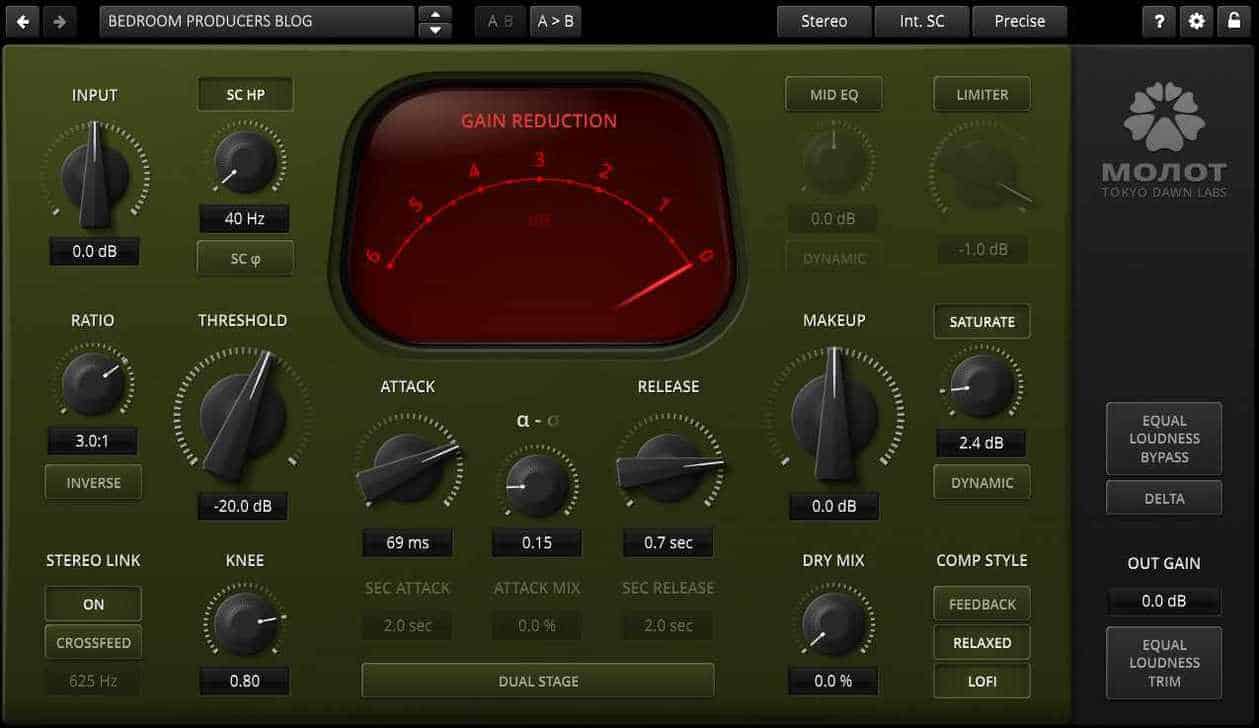Tokyo Dawn Records has released TDR Molotok, a freeware compressor effect in VST, VST3, AU, and AAX plugin formats for PC and Mac. The plugin is the simplified free edition of the new TDR Molot GE (€40) compressor.
The free TDR Molotok and paid TDR Molot GE are based on the legendary Molot freeware compressor by Vladislav Goncharov. He is also the developer behind Limiter №6, another “Hall of Fame” freeware plugin (and one of the top picks in our list of free limiter VST plugins).
So, what’s new in TDR Molotok, and should you upgrade?
TDR Molotok
I still haven’t put TDR Molotok through its paces on any serious project because the plugin has only been available for a few hours when writing this article. My initial impressions are that, much like the original Molot, it sounds fantastic on drums and percussion.
TDR Molotok can glue an acoustic drum mix like it’s no big deal. You can also use it to add grit and character to individual drum hits. Or, go completely crazy with it and use it as a hammer for smashing drum loops into pieces (after all, the word Molotok means “Small Hammer” in Russian).
The most significant difference between the original Molot and Molotok is in the GUI design. The new plugin sports a brand new user interface, both visually and in terms of functionality.
Now, I’m a big fan of the classic Molot design and its Cyrillic lettering, but I do like the updated control layout in Molotok. Most of the knobs are placed differently, and the new structure makes a lot of sense.
Perhaps more importantly, TDR Molotok introduces numerous workflow enhancements like A/B testing buttons, a bypass switch, a resizable GUI (from 100% to 150%), and an adjustable refresh rate. You’re also getting a preset manager, which was lacking in the original.
The workflow enhancements don’t stop there. The user can copy and paste settings between multiple plugin instances, adjust the GR meter’s gain range, and change the mouse sensitivity when dragging a control. As much as I loved the old Molot interface, TDR Molotok truly is an upgrade over the original.
Also worth noting are the new plugin formats. The original Molot was only available as a VST2 and Audio Unit plugin. TDR Molotok adds VST3 and AAX plugin formats to the list.
TDR Molot GE
TDR Molot GE is the “full” version of TDR Molotok. Before comparing it to Molotok, here’s a quick introduction.
Tokyo Dawn Records is known as one of the plugin developers that offer the most “bang for the buck” on the market. Their “GE” or “Gentleman’s Edition” plugins are reasonably priced and provide substantial upgrades over their freeware counterparts.
At the same time, TDR’s free VST plugins never feel crippled or as something that’s only there to push you into purchasing the “real deal.”
As expected, this is also the case with TDR Molot GE. It is a significant upgrade over TDR Molotok, but the free version is still a capable compressor on its own.
TDR Molot GE takes all the features from TDR Molotok and adds a limiter, saturation control, three compression modes (Feedback, Relaxed, and LoFi), stereo link, crossfeed control, equal loudness bypass, and more.
The new TDR Molot GE costs €40 at Tokyo Dawn records and $40 over at PluginFox.
Free Download
TDR Molotok is available for direct free download from Tokyo Dawn Records. No registration is required.
The software is available in VST, VST3, AU, and AAX plugin formats for digital audio workstations on PC and Mac. Both 32-bit and 64-bit plugin hosts are supported.
More info: TDR Molotok / TDR Molot GE (32-bit & 64-bit VST/VST3/AU/AAX plugin format for Windows & macOS)
More articles:






30 Comments
Paul sullivan
onnice one, i like what Tokyo Dawn do
tylab
onTDR has done more to enable bedroom producers than any other plugin developer with its free (simple, quick install) plugins and affordable full versions.
Kotelnikov, slick eq, limiter no6 and nova are all absurdly powerful, easy to use and together cover virtually everything you need for production.
I will definitely be checkIng out this new molotok!
Brenners
onMore than any other plugin dev? Kindly, respectably, wholeheartedly disagree with that statement. However, TDR does have a few decent limiters and compressors.
Bani
onDo elaborate…
John
onIn Molot you can change language to English.
GB
onThe pictures of the Molotok UI are in English.
From the Molotok maual:
“Additional options can be accessed using the standard context menu. This can be opened by right-clicking on a blank area anywhere in the UI. A click outside of the menu closes it.
User Interface offers language options.
Language
English displays the English language in the UI.
Russian displays the Russian language in the UI.”
John
onI was talking about Molot, not Molotok
>Now, I’m a big fan of the classic Molot design and its Cyrillic lettering
DungeonMaster
onI liked original Molot cause of limiter and mid color sections. It was pretty handy in most situations for me, especially with drums. Can’t see any reasons to go down from original Molot to Molotok. Because it really just downgrade with more polished interface. Still kinda prefer old gui ahah. GE looks really good in every aspect though.
Jeff
onYeah, I agree with this. Why switch to more limited functionality (unless I am missing something)?
Michal O.
onThere have been reports scattered online, about original Molot compatibility issues in Windows 10. I did a search a few months ago, because I was curious how this plugin performed in newer OS. I’m still on Windows 8.1. Molotok may be a good alternative for some users.
heavymetamixer
onMaybe because of the color possibilities? It doesn’t sound the same, the sound quality is bigger.
SNTMNTL
onOriginal Molot had a strange attack behaviour, something was off about it, both modes did not really work for me. I guess this new TDR version has more accurate compression behavior compared to the old oneS
Michal O.
onI had mixed experience with original version. Sometimes it worked well and other times, more often really, it took me unusually long to set it the way I wanted. Even then I wasn’t completely happy with results. Unreliable VU meter didn’t help either.
compo5er
onThe programmers say:
Q: Is it my impression or it sounds more clean than the Vladg version?
A: Not really cleaner, but has far less digital side-effects. Means you can drive it somewhat harder than the old one, without having the sound fall apart.
heavymetamixer
onAKA Less aliasing. That’s something known of TDR, they have really good oversampling implementations.
Jeff
onDoes that mean the oversampling in the original didn’t take care of the aliasing?
heavymetalmixer
onIt wasn’t as good. Oversampling doesn’t eliminate all Aliasing, it reduces the Aliasing, and the oversampling on the original Molot didn’t reduce it as much.
Origin Makers
onMolotok is gud…. But now liking the original Molot even more
Masked tiger
oni don’t lhe GUI but the vst looks nicee
K.S.S
onOld molot is still the best, I don’t think I’ll replace it with the new one any time soon.
Vogbog
onThere’s a bug in the UI of the plugin, it’s changing the screen resolution of Reason (Daw) to a higher one on surface pro. Quite bizarre really!
N.
onYep, experiencing the same thing.
Kyle L
onFor those concerned about it being a downgrade. Thats only the free version. The molot GE has the same features as the original plus more.
DgU
onI was hearing a difference between the original and the free new version(I did a blind test and I always picked the original), I just didn’t know what it was. After some analyzing a notice that the default preset in the original and default preset in the new version create saturation differently. Then I tested the paid version and although you can control the saturation level, the original and the new version still differ. I’ll stick to the original version, tbh.
Harakara
onIf you prefer aliasing and strange attack behavior for some unknown reason then stick with the old version. If you prefer good sound quality then take the new version.
Caleb
onThe strange attack behavior can actually be set up in the new one. I found this from the manual for Molot GE (though the alpha-sigma buttons are in Molotok, too):
α–σ (alpha–sigma) weighting sets the attack curve shape. In “alpha” mode the compressor reacts almost immediately. In “sigma” mode the compressor action is delayed and the attack passes through almost untouched. “Sigma” mode also has less distortion added to the signal.
Tip: If you’re using the compressor for transient suppression then “alpha” mode is recommended. If you’re using the compressor for transient shaping then “sigma” mode is recommended.
Note: “Sigma” mode brings about the sound that Molot is famous for.
MOS
onI use the molot in form of the C1L1 in Reason as paid Rack Extension and the Sound ist not as full as the sound of c670 from mcdsp or with the fast response of Softubes fet comp, but i know its capabilities for drum shaping and as the most common limiter, with its aliasing overdrive problem.
Thanks for the info with the alpha and sigma mode Caleb. I often use the Transient+ vst with molot behind, amazing combo.
antti maatteri
oni liked all of goncharovs stuff and still use it, and i like the tdr stuff, even if its just to PAY back goncharov the respect he deserves for his works. and of course tdr for its consistency
Mcl
onYes. Finally i can use it, the original version was too complex for me.
Glad the other pros prefer the older gui, as a newbie for me is exactly the opposite.
N.
onYep, experiencing the same thing.